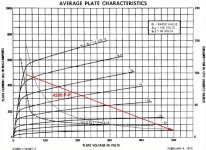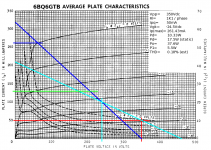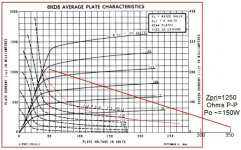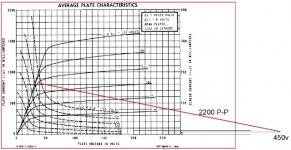Greetings,
Can anyone suggest what transformer impedance I should start with for push-pull sweep tubes? Here's what I do know.....
1)Eb=~500v
2)G2=~200v
3)Pd=~30w
I'm thinking 6LQ6's in AB1. Since there is no data for audio service on these tubes, let alone AB1, my first thought was 50ma of Ib with no signal. My first thought was 2K P2P on the OPT.
Thanks,
Ray
Can anyone suggest what transformer impedance I should start with for push-pull sweep tubes? Here's what I do know.....
1)Eb=~500v
2)G2=~200v
3)Pd=~30w
I'm thinking 6LQ6's in AB1. Since there is no data for audio service on these tubes, let alone AB1, my first thought was 50ma of Ib with no signal. My first thought was 2K P2P on the OPT.
Thanks,
Ray
Greetings,
Can anyone suggest what transformer impedance I should start with for push-pull sweep tubes? Here's what I do know.....
1)Eb=~500v
2)G2=~200v
3)Pd=~30w
I'm thinking 6LQ6's in AB1. Since there is no data for audio service on these tubes, let alone AB1, my first thought was 50ma of Ib with no signal. My first thought was 2K P2P on the OPT.
Thanks,
Ray
What is your power output and damping factor goal?
Eb=500 and Eg2=200 are within the max ratings for the 6LQ6 but don't make sense for 30 watts dissipation in a class AB audio amp.
If you want to run 6LQ6s at 500V, I think a better Zpri might be in the 4000 ballpark. There is no reason to run g2 over 120V. This would give you about 100W output in AB1, and would be close to the 30W dissipation limit. It would also give you a reasonable damping factor without too much NFB.
Michael
Attachments
Greetings,
Can anyone suggest what transformer impedance I should start with for push-pull sweep tubes?
Since these horizontal deflection types tend to operate at higher currents and lower voltages, they aren't going to require such high impedance transformations.
Here's a loadline for the 6BQ6GTB. As you can see, it requires just 1K1 / phase. That gets you better than 37W, and the Pd spec busting doesn't matter in audio final service, as this is much less demanding than horizontal deflection duty.
I happened to have a NOS, Stancore OPT that was originally intended for use with Class A 6L6s that worked just fine here, other than the 30W rating, and that the core saturates before the finals actually clip. I'm still getting 32W of output.
Attachments
Good morning Michael,
I came across an OPT rated at 60 watts and a primary Z of 4.2K. What do you think? I haven't found any 100 watters with that kind of primary Z.
Ray
I came across an OPT rated at 60 watts and a primary Z of 4.2K. What do you think? I haven't found any 100 watters with that kind of primary Z.
Ray
What is your power output and damping factor goal?
Eb=500 and Eg2=200 are within the max ratings for the 6LQ6 but don't make sense for 30 watts dissipation in a class AB audio amp.
If you want to run 6LQ6s at 500V, I think a better Zpri might be in the 4000 ballpark. There is no reason to run g2 over 120V. This would give you about 100W output in AB1, and would be close to the 30W dissipation limit. It would also give you a reasonable damping factor without too much NFB.
Michael
Since these horizontal deflection types tend to operate at higher currents and lower voltages, they aren't going to require such high impedance transformations.
Here's a loadline for the 6BQ6GTB. As you can see, it requires just 1K1 / phase. That gets you better than 37W, and the Pd spec busting doesn't matter in audio final service, as this is much less demanding than horizontal deflection duty.
I happened to have a NOS, Stancore OPT that was originally intended for use with Class A 6L6s that worked just fine here, other than the 30W rating, and that the core saturates before the finals actually clip. I'm still getting 32W of output.
Miles, that's certainly another option, to drop the B+ by 150V or so and use a lower impedance load. I was sticking with the 500V B+, since sweep tubes operate great at higher voltages also. Anyway, 1K1 per phase *is* 4400 ohms P-P in class AB. So you and I are recommending the same Zpri...
The 6LQ6 is a much beefier tube than the 6BQ6 and can certainly work at lower impedance loads and high currents. But at a lower B+ than 500V. Now maybe 6LF6s pushed to 50W in a 150W amp
BTW, you probably can push these to more than 30W but if you can make a 100WPC amplifier, why do so? 6LQ6s are not to be found on tree limbs these days!
Cheers,
Michael
Good morning Michael,
I came across an OPT rated at 60 watts and a primary Z of 4.2K. What do you think? I haven't found any 100 watters with that kind of primary Z.
Ray
That one would work but be a little undersized.
Russ suggests the Edcor CXPP100, which is exactly what I was thinking at about $90 each
(assuming you want to build a 100WPC amp)
Michael
Greetings again,
So looking through my tubes, I came across a pair of 6LF6's. Any suggestions on using these? I have small regulated supplies for the screen that I can use of 150, 175, 200, or 250 v and can do up to 750 v on the plate at 500ma. Any suggestions on getting these into class AB1 would be appreciated.
Ray
So looking through my tubes, I came across a pair of 6LF6's. Any suggestions on using these? I have small regulated supplies for the screen that I can use of 150, 175, 200, or 250 v and can do up to 750 v on the plate at 500ma. Any suggestions on getting these into class AB1 would be appreciated.
Ray
Miles, that's certainly another option, to drop the B+ by 150V or so and use a lower impedance load. I was sticking with the 500V B+, since sweep tubes operate great at higher voltages also. Anyway, 1K1 per phase *is* 4400 ohms P-P in class AB. So you and I are recommending the same Zpri...
The 6LQ6 is a much beefier tube than the 6BQ6 and can certainly work at lower impedance loads and high currents. But at a lower B+ than 500V. Now maybe 6LF6s pushed to 50W in a 150W amp
BTW, you probably can push these to more than 30W but if you can make a 100WPC amplifier, why do so? 6LQ6s are not to be found on tree limbs these days!
Cheers,
Michael
6LF6 is a wonderful tube. I used it in screen-drive with 1250 ohms plate to plate and a 650V plate supply. Easily hit 150W, with a reasonable distortion spectrum. You could probably do something similar with running AB2 pentode. The basic idea is to take advantage of the perveance to get watts without excess screen dissipation.
So looking through my tubes, I came across a pair of 6LF6's. Any suggestions on using these? I have small regulated supplies for the screen that I can use of 150, 175, 200, or 250 v and can do up to 750 v on the plate at 500ma. Any suggestions on getting these into class AB1 would be appreciated.
Look through this thread:
http://www.diyaudio.com/forums/tubes-valves/151206-posted-new-p-p-power-amp-design.html
I have run several different tube types through this board including 6LF6's. Most of thoae tests are in posts 220 through 270. I have seen sweep tubes of this size crank out from 100 to 200 WPC with a 600 volt supply and a load from 2500 ohms to 3300 ohms.
6LF6 is a wonderful tube. I used it in screen-drive with 1250 ohms plate to plate and a 650V plate supply. Easily hit 150W, with a reasonable distortion spectrum. You could probably do something similar with running AB2 pentode. The basic idea is to take advantage of the perveance to get watts without excess screen dissipation.
SY,
Something here doesn't add up for me. I don't have 6LF6 plate curves, but I'm looking at a very similar tube, the 6KD6, which also supports a 1250 ohm P-P load.
It looks to me like only about 350V B+ is needed to produce 150 watts into 1250 ohms P-P load (class AB screen drive).
I also plotted 40W plate dissipation on this chart to represent the 6LF6...
Michael
Attachments
Yes, one has to avoid melting the tubes- that's probably the power limit. Unlike George, I don't like killing output tubes just to see what happens. I'm sure I could have gotten more power for a short time...
My amp ran near-class-B, so it was pretty cool at most usage.
smoking-amp's traces of a 35LR6 (6LR6 with a 35V heater) line up almost exactly with the published 6KD6 curves so I think these are representative of a 6LR6.
http://www.diyaudio.com/forums/tube...-new-p-p-power-amp-design-27.html#post2080702
450V and 2200 ohms would be another possible OP for 150W Po as shown below.
Ray, you might get the idea by now. A wide range of primary impedance can be used with B+ and Vg2 scaled to the load line at your desired Po, as long as you don't exceed Pd. As George says, 2500 ohms - 3300 ohms or others can also be used.
If you are planning to use Schade feedback, there are limits on the output resistance achievable at the speaker terminals based on the gm and OPT ratio. It's something like 1/gm * (Zsec/(Zpp/4)) for class AB assuming V/I feedback to a pentode driver. For example, a pair of 6LR6 at gm~=13000 into 2200 ohms P-P would have output resistance on the order of 1.1 ohms using Schade feedback.
Attachments
Unlike George, I don't like killing output tubes just to see what happens. I'm sure I could have gotten more power for a short time...
To borrow some words from an old cowboy movie, " but sheriff, they needed killin."
I might be guilty of killing a few tubes "just to see what happens" but you won't see me frying up any of the types that have been mentioned here. Yes, I got some 6LF6's for a dollar at a recent hamfest (OK $2 if you count the dead ones) and I nail down some big sweep tubes cheap every now and then on Ebay ($5 or $6 is my maximum "bet"), but I don't "play" with these, thats what the "dollar tubes" are for. I also have a good collection of cosmetically challenged tubes that are so ugly that no one wants them. Many have cracked bases, missing guide pins, or badly corroded pins. These don't have much other use except for "testing".
There is another aspect here. It is one thing to crank a tube to the glow zone with the old Fluke 407D. That old power supply has seen more than a few direct shorts across its outputs. I am sure that it doesn't like it, and the old 807's inside should be dead by now, but nothing really bad is going to happen if a glowing tube shorts out. My experiments with the red board have been fed by a power supply that blew an electrolytic in half without even flinching. I don't want to know what would happen if a tube should arc. About 10 years ago I saw a Chinese KT88 explode in flames in one of my guitar amps. I still have about 30 more of those vintage Chinese firecrackers, but my testing will be more reserved until I can build a "explosion proof" box out of say 1/2 inch Lexan"!
Some would say that I should fuse the supply output. Tried that, was picking up tiny glass fragments for a week. Standard sized glass fuses can't deal with a 650 volt 500 amp arc right through them. It takes out the socket too. It's all over before the current limiter ever kicks in.
To borrow some words from an old cowboy movie, " but sheriff, they needed killin."
Just to be clear, I didn't mean that as a criticism- the stuff you do in this direction is VERY useful data gathering for pussies like me who Fear the Flash.
Just to be clear, I didn't mean that as a criticism
I didn't take it as one either. I just explained that some tubes are meant for listening, and some just need killin. There is lots of room for some experiments in between. Seriously the cheapskate in me doesn't even let me buy expensive tubes. The most expensive tubes that I have ever purchased were some Chinese 300B's, and I got them when they were $40 each. I usually experiment with stuff that I got for free, or real cheap ($1). I don't plug in the good stuff until I have confidence that they won't blow up.
the stuff you do in this direction is VERY useful data gathering for pussies like me who Fear the Flash.
I started playing with tubes at a very young age. I dragged home radios from the trash in elementary school and made a few work by swapping tubes around. Some radios made this buzzing sound that I didn't understand. There was this radio station engineer living near me that would answer my questions. He explained about bad capacitors. You can guess what happened when I tried to change one.
My early electronics education came from magazines, books, asking questions, and experiments. Most of my early experiments ended with a flash, bang, or smoke. There was so much of it that I was not allowed to play with electricity inside the house. Think about this, the wall outlet, hot chassis radios and TV's, and a concrete floor in a humid doorless garage. I got zapped a lot before I really understood what was going on.
By middle school I had learned how to make guitar amps from scratch using old TV parts, but I didn't understand why the little tubes (6BQ6's) were louder than the big tubes (6DQ6's) in my SE amps. I also didn't understand why tubes sometimes glowed red, and the amp sounded really cool when they did. Yes, I blew up a lot of tubes. Capacitors, resistors, and even transformers too. Looking back, I don't blame my parents for keeping the aroma of fried parts out in the garage. Electrolytics and transformers stink!
By the time I entered high school the garage was closed in and air conditioned and became my bedroom. The experiments moved indoors. I enroled in a 3 year vocational electronics program in high school where we played with tubes. Oddly enough most of my "experiments" were done with the knowledge and tolerance of the teacher. I think that he was genuinely curious as to what would happen. We had tons of military surplus stuff to play with including about 50 Stromberg Carlson PA amplifiers that used 4 6L6GB's. We only had metal 6L6's so we used them (we had hundreds of new ones). There was a rivalry between 3 of us to see who could get the most power out of one.
That was 40 years ago and today the rusty old Stromberg chassis is now Petes red board, but the experiments are the same! I don't see any reason to change the formula now. Look at it this way, I blow stuff up so you won't have too.
I blow stuff up so you won't have too.
Time to change your signature, George.
- Status
- This old topic is closed. If you want to reopen this topic, contact a moderator using the "Report Post" button.
- Home
- Amplifiers
- Tubes / Valves
- Transformers for Push-Pull sweep tubes



